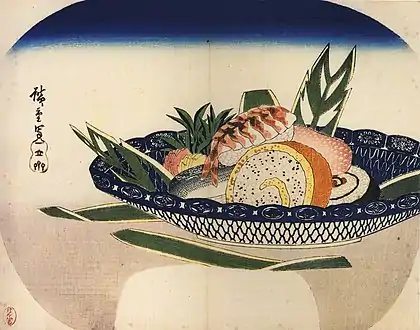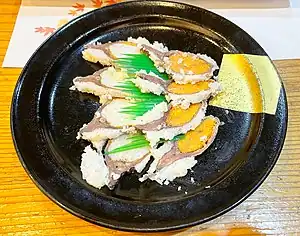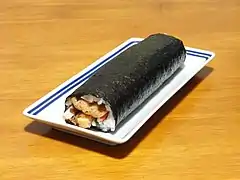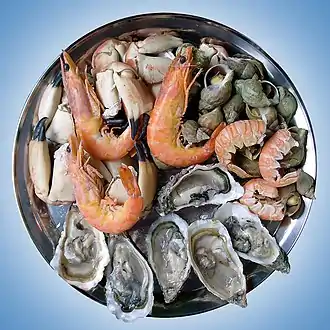
The history of sushi (すし, 寿司, 鮨, pronounced [sɯɕiꜜ] or [sɯꜜɕi]) began with paddy fields, where fish was fermented with vinegar, salt and rice, after which the rice was discarded. The earliest form of the dish, today referred to as narezushi, was created in Japan around the Yayoi period (early Neolithic–early Iron Age).[1] In the Muromachi period (1336–1573), people began to eat the rice as well as the fish.[2] During the Edo period (1603–1867), vinegar rather than fermented rice began to be used. The dish has become a form of food strongly associated with Japanese culture.[3]
The inventor of modern sushi is believed to be Hanaya Yohei, who invented nigiri-zushi, a type of sushi most known today, in which seafood is placed on hand-pressed vinegared rice, around 1824 in the Edo period. It was the fast food of the chōnin class in the Edo period.[4][5][6]
Early history
The earliest form of sushi, a dish today known as narezushi, originated in Southeast Asia where it was made to preserve freshwater fish, possibly in the Mekong River basin, which is now Laos, Cambodia, and Thailand, and in the Irrawaddy River basin, which is now Myanmar.[7] Narezushi in ancient China is first documented around the 4th century, when the Han Chinese migrated south to adopt this food from the Baiyue (the original non-Han inhabitants of southern China in the Neolithic, related to modern Southeast Asians).[1]
Similar modern dishes which ferment fish in rice (or other grains) in other Asian rice cultures include burong isda, balao-balao, and tinapayan of the Philippines; pekasam of Indonesia and Malaysia, pla ra (ปลาร้า) of Thailand; and sikhae (식해) of Korea.[8][9][10][11]
The prototypical narezushi is made by lacto-fermenting fish with salt and rice in order to control putrefaction. In Japan the dish's distribution overlaps with the introduction of wet-field rice cultivation during the Yayoi period.[1][12] Passages relate ancient Japanese people with legendary King Shao Kang ruling over the Yangtze delta:[13]
Men great and small, all tattoo their faces and decorate their bodies with designs. From olden times envoys who visited the Chinese Court called themselves "grandees" [大夫]. A son of the ruler Shao Kang of Xia, when he was enfeoffed as lord of Kuaiji, cut his hair and decorated his body with designs in order to avoid the attack of serpents and dragons. The Wa, who are fond of diving into the water to get fish and shells, also decorated their bodies in order to keep away large fish and waterfowl. Later, however, the designs became merely ornamental.
During the third century, Chinese travelers in Japan recorded examples of Wu traditions including ritual teeth-pulling, tattooing and carrying babies on backs. Other records at the time show that Japan already had the same customs recognized today. These include clapping during prayers, eating from wooden trays and eating raw fish (also a traditional custom of Jiangsu and Zhejiang before pollution made this impractical).[14]
Narezushi appears in the Chinese dictionary in the second century CE as the character sa (鮓, pickled fish with salt and rice),[15] which was during a period in which the Han Chinese were expanding south of the Yangtze river, adopting the food from the non-Han peoples.[1] Kuai, sashimi, and hoe can be traced back to Dongyi, a pre-Han Baiyue cultural area in East China. Confucius was born near present-day Nanxin Town, Qufu, Shandong, China, and he was known to have enjoyed eating raw meat.[16]
Sushi in Japan
In the Yōrō Code (養老律令, Yōrō-ritsuryō) of 718, the characters for "鮨" and "鮓" are written as a tribute to the Japanese imperial court, and although there are various theories as to what exactly this food was, it is possible that it referred to narezushi.[17]
Until the early 19th century, sushi slowly changed and the Japanese cuisine changed as well. The Japanese started eating three meals a day, rice was boiled instead of steamed, and of large importance was the development of rice vinegar.[18]
During the Muromachi period (1336–1573), the Japanese invented a style of sushi called namanare or namanari (生成、なまなれ、なまなり), which means "partially fermented". The fermentation period ofnamanare was shorter than that of the earlier narezushi, and the rice used for fermentation was also eaten with the fish. In other words, with the invention of namanare, sushi changed from a preserved fish food to a food where fish and rice are eaten together. After the appearance of namanare, sake and sake lees were used to shorten fermentation, and vinegar was used in the Edo period.[7]
During the Edo period (1603–1867), a third type of sushi, haya-zushi (早寿司、早ずし, "fast sushi"), was developed. Haya-zushi differed from earlier sushi in that instead of lactic fermentation of rice, vinegar, a fermented food, was mixed with rice to give it a sour taste so that it could be eaten at the same time as the fish. Previously, sushi had evolved with a focus on shortening the fermentation period, but with the invention of haya-zushi, which is simply mixed with vinegar, the fermentation process was eliminated and sushi became a fast food. Many types of sushi known in the world today, such as chirashizushi (散らし寿司, "scattered sushii"), inarizushi (稲荷寿司, "Inari sushi"), makizushi (巻寿司, "rolled sushi"), and nigirizushi (握り寿司, "hand-pressed sushi"), were invented during this period, and they are a type of haya-zushi. Each region utilizes local flavors to produce a variety of sushi that has been passed down for many generations. A 1689 cookbook describes haya-zushi, and a 1728 cookbook describes pouring vinegar over hako-zushi (箱ずし, "box sushi") (square sushi made by filling a wooden frame with rice).[7]
Today's style of nigirizushi (握り寿司), consisting of an oblong mound of rice with a slice of fish draped over it, became popular in Edo (contemporary Tokyo) in the 1820s or 1830s. One common story of the origin of nigirizushi origins is of the chef Hanaya Yohei (1799–1858), who invented or perfected the technique in 1824 at his shop in Ryōgoku.[19] The nigirizushi of this period was somewhat different from modern nigirizushi. The sushi rice of this period was about three times the size of today's nigirizushi. The amount of vinegar used was half that of today's sushi, and the type of vinegar developed during this period, called aka-su (赤酢, "red vinegar"), was made by fermenting sake lees. They also used slightly more salt than in modern times instead of sugar. Seafood served over rice was prepared in a variety of ways. This red vinegar was developed by Nakano Matazaemon (中野 又佐衛門), who is the founder of Mizkan, a company that still develops and sells vinegar and other seasonings today.[7]
Raw salmon flesh may contain marine parasites such as Anisakis nematodes, that cause anisakiasis. Before the availability of refrigeration, Japan did not consume raw salmon for this health risk. Salmon and salmon roe have only recently come into use in making sashimi (raw fish) and sushi in the late 1980s. The introduction was from parasite-free Norwegian salmon belonging from Norwegian fishing companies who had an oversupply of farmed fish and were looking for a country to sell it off to. A deal resulted with Japanese company Nichirei for 5000 tons of salmon which started salmon sushi consumption in Japan.[20]
Funazushi

Funazushi is a rare type of narezushi prepared near Lake Biwa, Shiga Prefecture.[21] Eighteen generations of the Kitamura family have been preparing the dish at Kitashina since 1619.[22]
Fresh funa are scaled and gutted through their gills or throat keeping the body (and always the roe) of the fish intact.[23] The fish are then packed with salt and aged for a year before being repacked annually in fermented rice for up to four years. The resulting fermented dish may be served sliced thin or used as an ingredient in other dishes.[24]
Authentic funazushi is made from a wild subspecies of goldfish called nigorobuna (a wild type of Carassius auratus) endemic to the lake. It is technically misleading to say that "crucian carp" is used, as though any funa-type carp in the genus may be substituted, especially since the true crucian carp is a distinct species altogether (C. carassius) and is not indigenous to Lake Biwa.[25]
Makizushi

After the invention of the sheet form of nori seaweed around 1750, makizushi or norimaki, rice and various ingredients rolled with nori appeared.[26][27] The term makizushi was first used in the book Ryōri Sankaikyō (料理山海郷), published in 1749. However, this dish did not resemble the current-day makizushi, but was instead seafood rolled with bamboo mat (makisu).[28][29][30] Current-day makizushi first appeared in the book Shinsen Kondate buruishū (新撰献立部類集), published in 1776, which describes how makizushi is made: "Place a sheet of asakusa-nori, pufferfish or paper on the makisu and spread the cooked rice then arrange fishes on it. Roll the makisu tightly from one side".[26][28][29][31] In 1778, a food shop guide book Shichijyūgonichi (七十五日, 1778) listed a shop whose most famous dish was "norimaki-zushi".[26] A later book Meihan Burui (名飯部類, 1802) describes the process of making makizushi: "Spread asakusa-nori on the board, place the sushi rice on it. Ingredients are sea bream, abalone, shiitake, mitsuba and shiso. Roll them firmly".[27][29][32]
Sushi and Western culture
The Oxford English Dictionary notes the earliest written mention of sushi in an 1893 book, Japanese Interiors, where it mentions that "Domestics served us with tea and sushi or rice sandwiches".[33][34] However, there is also mention of sushi in a Japanese-English dictionary from 1873,[35] and an 1879 article on Japanese cookery in the journal Notes and Queries.[36] Additionally, the 1879 best-selling book A Tour Around the World by General Grant by James Dabney McCabe describes former president Ulysses S. Grant dining on the "shashimi" [sic] version of sushi during his visit to Japan.[37]
United States

Sushi was already being served in the United States by the early 1900s, following an influx of Japanese immigration after the Meiji Restoration.[37] The first sushi shop in the U.S. reportedly opened in 1906 in the Little Tokyo neighborhood of Los Angeles.[38] H.D. Miller, food historian of Lipscomb University has written that a wave of Japanophilia in American high society resulted in the serving of sushi at social functions. Popularity of Japanese food peaked around 1905 when it was being served at Japanese-themed social gatherings across the United States, including in midwestern cities such as Minneapolis, Minnesota, St. Louis, Missouri and Bismarck, North Dakota.[37] According to Miller, the earliest published mention of sushi eaten by an American, in America, was an 18 August 1904 article in the Los Angeles Herald about a luncheon served in Santa Monica by the socialite Fern Dell Higgins.[37]
Several years later, a wave of anti-Japanese nativism sentiments and restrictions on Japanese immigration, starting with the Gentlemen's Agreement of 1907, caused a subsequent decline in the acceptance of Japanese cuisine.[37] After the outbreak of World War II, Japanese-American restaurants on the West Coast were generally forced to close and sell off their businesses due to internment orders on their proprietors.[39] One restaurant that reopened after the war to serve sushi was Matsuno Sushi (Matsu-no-sushi) in Little Tokyo, Los Angeles. This restaurant had been in business at least since 1938 or 1939,[40][41] and by 1949, it was back serving sushi (featuring local bluefin tuna[42]) for lunch. But the maki and inari they served was not shaped by hand by trained chefs, but molded in cookie-cutters.[43]
The Kawafuku restaurant in Little Tokyo has been credited with being the "first true sushi bar" in the United States,[44] that is to say, the first to serve sushi from a trained sushi chef in the country.[45][46] Some sources accept the claim made by a man named Noritoshi Kanai that he was the person instrumental in persuading Kawafuku's owner to start the sushi section. Kanai has also claimed to be the person who coined the term "sushi bar". Kanai headed the Tokyo-based arm of Mutual Trading, an importer of Japanese food ingredients that served Kawafuku and other restaurants.[47][46] The first sushi chef in America according to this account was Shigeo Saito, and some sources paint the chef as the principal figure who brought real sushi to the U.S.[44]
Articles that gave positive views of tourism to Japan and Japanese cuisine began appearing in the media in the United States in the 1950s, paving the way to the public accepting different kinds of Japanese cuisine.[48]
Though the true origin is disputed, many believe the California roll was invented in Los Angeles by substituting a slice of avocado for the seasonal toro (fatty tuna) in a traditional maki roll.[49]
United Kingdom
A report of sushi being consumed in Britain occurred when the then Crown Prince Akihito (born 1933) visited Queen Elizabeth II at the time of her Coronation in May 1953.[50][51]
Canada
Although sushi was first served in Canada with the first arrivals of Japanese immigrants during the 19th century, it was not until changes to immigration rules in the 1960s that it started becoming widely available.[52] Vancouver in particular went from 3 sushi outlets in 1976 to more than 600 in 2014, a larger number per capita than in Canada's largest city Toronto.[53] Although the true origin is disputed, it's widely believed that Chef Hidekazu invented the California roll (originally called "Tojo-maki") in Vancouver, by inverting the roll and putting rice on the outside to make it more accessible to Western tastes, and adding non-traditional ingredients like avocado.[54] The B.C. roll was also invented in Vancouver by Hidekazu in 1974 using barbecued salmon.
Australia
Australia is a major source of rice used in sushi, in particular Leeton, New South Wales, which is the headquarters of SunRice.[55][56]
Sushi is believed to have been introduced into Australia between the early 1970s[57] and the 1980s.[58] The first known sushi conveyor belt in Australia appeared in Queensland in 1993, when Sushi Train opened its first restaurant.[59]
New Zealand
When David Bowie played in Auckland in 1983 as part of the Serious Moonlight Tour, it was rumoured his contract rider stated that sushi be on the menu, which at the time was rare and exotic in New Zealand,[60] and typically served only in high-end city restaurants.[61]
St Pierre's, a nationwide food franchise, officially began serving sushi in 1993,[62] after originally being established as a seafood delicatessen in Wellington in 1984.[63]
See also
References
- Citations
- 1 2 3 4 Lee, Cherl-Ho; Steinkraus, Keith H.; Reilly, P. J. Alan (1993). Fish Fermentation Technology. pp. 15–16. ISBN 9788970530031.
- ↑ Barakan, Peter. "Japanology Plus Sushi". NHK World. Archived from the original on 10 April 2017. Retrieved 5 April 2017.
- ↑ Barakan, Peter. "Begin Japanology". NHK World. Archived from the original on 10 April 2017. Retrieved 5 April 2017.
- ↑ "The Mysteries of Sushi - Part 2: Fast Food". Toyo Keizai. 23 May 2015. Archived from the original on 9 September 2017.
- ↑ "When Sushi Became a New Fast Food in Edo". Nippon.com. 22 December 2020. Archived from the original on 18 January 2021.
- ↑ "Sushi". Nihonbashi. Archived from the original on 28 December 2021.
- 1 2 3 4 Hirofumi Akano. "The evolution of sushi and the power of vinegar". Japan Science and Technology Agency. p. 201, 202. Archived from the original on 14 February 2023. Retrieved 4 April 2023.
- ↑ Sanchez, Priscilla C. (2008). "Lactic-Acid-Fermented Fish and Fishery Products". Philippine Fermented Foods: Principles and Technology. University of the Philippines Press. p. 264. ISBN 9789715425544.
- ↑ Lee, Cherl-Ho; Steinkraus, Keith H; Reilly, P.J. Alan (1993). Fish fermentation technology. Tokyo: United Nation University Press. OCLC 395550059. Archived from the original on 13 January 2021. Retrieved 17 June 2021.
- ↑ Hill, Amelia (8 October 2007). "Chopsticks at dawn for a sushi showdown". The Guardian. London. Archived from the original on 17 December 2007. Retrieved 25 September 2011.
- ↑ Guerra, M.I. (1994). "Studies on tinapayan, an indigenous fish ferment in Central Mindanao (Philippines)". AGRIS. 1 (2): 364–365.
- ↑ Hiroto Takamiya (2001). "Introductory Routes of Rice to Japan: An Examination of the Southern Route Hypothesis" (PDF). Asian Perspectives. University of Hawaii Press. 40 (2): 209–226. doi:10.1353/asi.2001.0026. hdl:10125/17154. S2CID 56144192.
- ↑ Tsunoda, Ryūsaku; Goodrich, L. Carrington (1951). Japan in the Chinese dynastic histories: Later Han through Ming dynasties. South Pasadena [Calif.: P.D. and I. Perkins. OCLC 1107990.
- ↑ Encounters of the Eastern Barbarians, Wei Chronicles
- ↑ "The complete history of sushi". Business Insider. 9 February 2015. Retrieved 1 August 2017.
- ↑ "공자 사모님 힘드셨겠네 : 김학민의 음식이야기". legacy.h21.hani.co.kr. Retrieved 11 January 2021.
- ↑ 握りずし 始まりは江戸っ子のホットドッグスタンド (in Japanese). Nikkei, Inc. 9 June 2018. Archived from the original on 28 October 2020. Retrieved 4 April 2023.
- ↑ Mpritzen, Ole G. (2009). Sushi: Food for the Eye, the Body and the Soul. Springer Science-Business Media. p. 15.
- ↑ Bestor, Theodore C. (13 July 2004). Tsukiji: The Fish Market at the Center of the World. p. 141. ISBN 9780520923584.
- ↑ "How The Desperate Norwegian Salmon Industry Created A Sushi Staple". NPR. 18 September 2015. Retrieved 27 February 2023.
- ↑ "The Kyoto Project: Funazushi". Kyoto University of Foreign Studies. 2 September 2013. Archived from the original on 6 July 2015. Retrieved 6 July 2015.
- ↑ Atsushi Kitamura (9 December 2008). "Japan". Bizarre Foods with Andrew Zimmern. Season 2. Episode 13. Travel Channel.
- ↑ Schiller, Tom. "Funazushi: The fermented predecessor of modern sushi". BBC. Retrieved 8 November 2022.
- ↑ Hiroya Kawanabe; Machiko Nishino; Masayoshi Maehata (2012). Lake Biwa: Interactions between Nature and People. Springer Science & Business Media. p. 344. ISBN 978-94-007-1783-1. Retrieved 6 July 2015.
- ↑ Hosking, Richard (1998), Walker, Harlan (ed.), "From Lake and Sea Goldfish and Mantis Shrimp Sushi" (preview), Fish, Food from the Waters: Proceedings of the Oxford Symposium on Food and Cookery, Oxford Symposium Press, pp. 160–161, ISBN 978-0-907325-89-5, p.161
- 1 2 3 Miyashita, Akira (2003). 海苔 [Nori]. Hosei University Press. ISBN 4588211110.
- 1 2 Katada, Minoru (1989). 浅草海苔盛衰記 [Asakusa nori rise and fall]. Seizando-Shoten Publishing. ISBN 442582251X.
- 1 2 Kawakami, Kōzō (2006). 日本料理事物起源 [Origin of Japanese cuisine]. Iwanami Shoten. ISBN 4000242407. Archived from the original on 26 January 2016.
- 1 2 3 Ōkawa, Tomohiko (2008). 現代すし学 [Sushiology]. Asahiya Publishing. ISBN 978-4751107270.
- ↑ Ryōri Sankaikyō (料理山海郷). Enshudō (園趣堂). 1819. Reprint edition of 1749
- ↑ Nakagawa, Tōshirō (1776). Shinsen Kondate buruishū (新撰献立部類集).
- ↑ Sugino, Gonbei (1802). Meihan Burui(名飯部類).
- ↑ "Sushi", Oxford English Dictionary, Second edition, 1989; online version December 2011. Retrieved 23 December 2011.
- ↑ Alice Mabel Bacon, "A Japanese interior", Houghton, Mifflin and Company, 1893, p.. 180)
- ↑ James Curtis Hepburn, Japanese-English and English-Japanese dictionary, Publisher: Randolph, 1873, 536 pages (p. 262)
- ↑ W.H. Patterson, "Japanese Cookery", Notes and queries, Publisher: Oxford University Press, 1879. (p. 263)
- 1 2 3 4 5 Miller, Howard D. (23 July 2015). "The Great Sushi Craze of 1905 The Unexpected History of Japanese Food in America, From Edo Bay to the Bowery". An Eccentric Culinary History. eccentricculinary.com. Retrieved 18 August 2015.
- ↑ Wank, David L.; Farrer, James (2015). "Chapter 5: Chinese Immigrants and Japanese Cuisine in the United States: a Case of Culinary Glocalization". The Globalization of Asian Cuisines. Springer. ISBN 9781137514080., citing Ishige, Naomichi; Koyama, Shuzou; Yamaguchi, Masatomo; Ekuan, Shouji (1985), ロスアンジェルスの日本料理店―その文化人類学的研究 (Rosuanjerusu no nihon ryōriten: sono bunka jinruigakuteki kenkyū) [Japanese restaurants in Los Angeles: an anthropological research] (in Japanese), Domesu Shuppan, pp. 28–33
- ↑ Smith (2012), p. 89.
- ↑ Interview of S. John Nitta in "Downtown: The Old Meets the New". Los Angeles Times. 10 October 1971.
- ↑ Listed in the 1939 directory: New World-sun Year Book 新世界朝日年鑑 (Shin-Sekai Asahi Nenkan), Los Angeles: New World Sun, 1939, p. 435 (misprinted as p. 535)
- ↑ Smith (2012), p. 93.
- ↑ Issenberg (2007), p. 80.
- 1 2 Issenberg (2007), p. 88.
- ↑ Corson (2008), pp. 45–46.
- 1 2 Al-Jamie, Anthony (15 May 2013). "The Man Who Brought Sushi to America". Tokyo Journal. Retrieved 30 March 2017.
- ↑ Smith (2012), p. 90.
- ↑ House, p. 46.
- ↑ McInerney, Jay (10 June 2007). "Raw". The New York Times. Retrieved 15 August 2008. (book review of Corson 2007 and Issenberg 2007)
- ↑ 30 May 1953 "Japanese women eating sushi whilst they wait to catch a glimpse of Prince Akihito, in England as a coronation guest of the Queen Archived 24 September 2015 at the Wayback Machine", photographer John Chillingworth, Picture Post at Getty Images
- ↑ "Prince Akihito Eats and Runs at Own Soiree Archived 19 March 2013 at the Wayback Machine", Chicago Daily Tribune, 4 May 1953, page 22
- ↑ Gabby Peyton. "IT'S CANADIAN: THE HISTORY OF THE CALIFORNIA ROLL". Food Bloggers of Canada.
- ↑ Douglas Todd (4 May 2014). "Vancouver may be sushi capital of North America".
- ↑ Madeleine White (23 October 2012). "Meet the man behind the California roll". The Globe and Mail. Retrieved 2015-07-06.
- ↑ "2007 Kikkoman Food Culture Seminar – The Internationalization of Sushi" (PDF). Archived (PDF) from the original on 4 October 2018. Retrieved 23 January 2018.
- ↑ Laurissa Smith (22 April 2014). "Sushi boom increases rice markets for Riverina growers". ABC.
- ↑ Hilary Neal (7 January 2006). "Is Aussie sushi fishy or real deal?". The Japan Times.
- ↑ "The History of Sushi". Sushi Machine.
- ↑ "Sushi Train – About us". Archived from the original on 24 July 2018. Retrieved 23 January 2018.
- ↑ Russell Brown (12 January 2016). "Hard News: Bowie". Public Address.
- ↑ Livia Esterhazy (3 June 2018). "Blockchain: the new frontier in the battle against slavery for sushi". The Spinoff.
- ↑ Errol Kiong (11 November 2008). "Chicken sushi conquered Kiwi tastebuds". The New Zealand Herald.
- ↑ "St Pierres – About Us". Archived from the original on 8 December 2019. Retrieved 8 December 2019.
- Bibliography
- Corson, Trevor (2007). The Zen of Fish: The Story of Sushi, from Samurai to Supermarket. HarperCollins. ISBN 978-0060883508.
- Corson, Trevor (2008). The Story of Sushi: An Unlikely Saga of Raw Fish and Rice. Harper Perennial. ISBN 978-0060883515.
- House, Jonas (2018). "Sushi in the United States, 1945–1970". Food and Foodways. 26 (1): 40–62. doi:10.1080/07409710.2017.1420353. S2CID 148999257. - Alternate URL Archived 23 July 2018 at the Wayback Machine at the White Rose University Consortium
- Issenberg, Sasha (2007). The Sushi Economy: Globalization and the Making of a Modern Delicacy. Penguin. ISBN 9781592402946.
- Smith, Andrew F. (2012). American Tuna: The Rise and Fall of an Improbable Food. University of California Press. ISBN 9780520954151. - See page 91
External links
- History of Sushi
- Sushi Dictionary (寿司用語辞典; in Japanese)
- Sushi Q & A (すしのQ&A; in Japanese)
- The History of Sushi.
